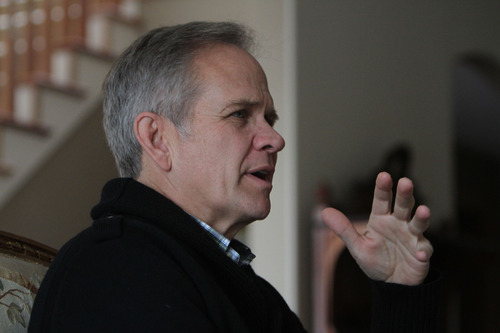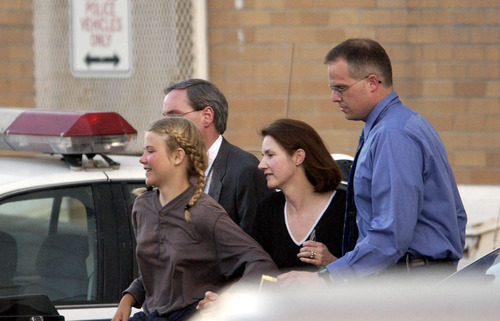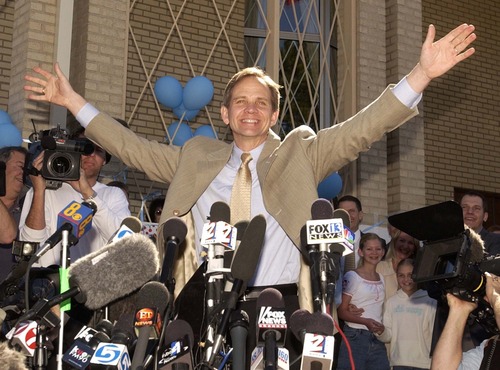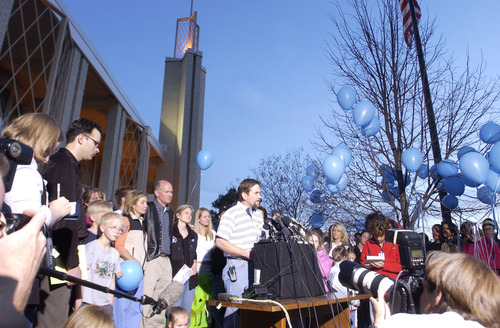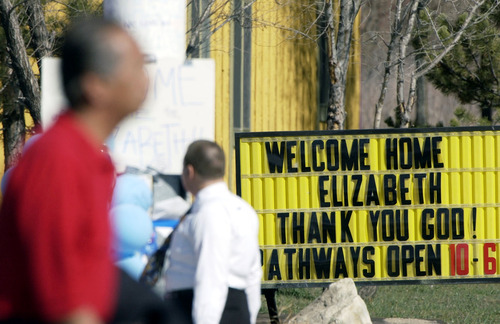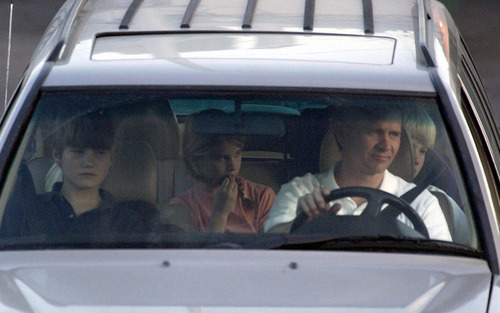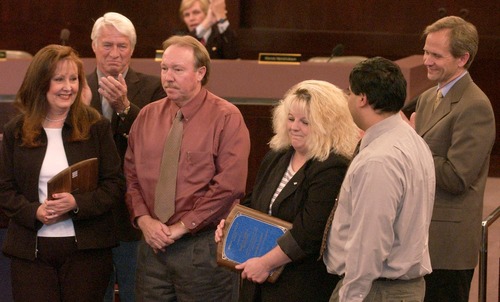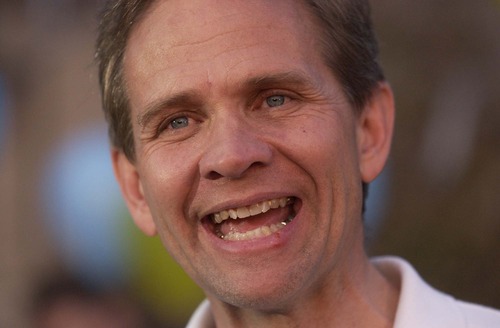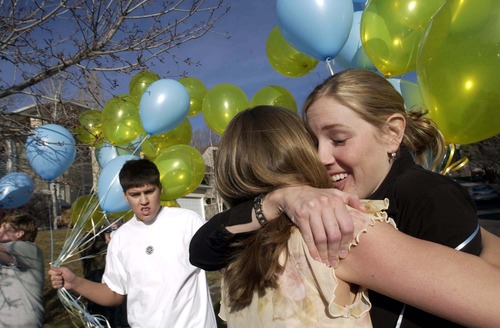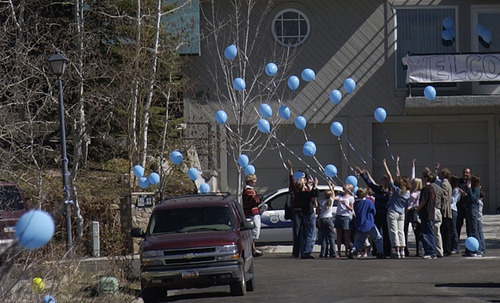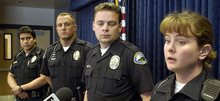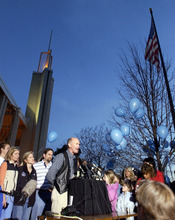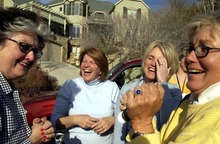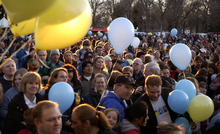This is an archived article that was published on sltrib.com in 2013, and information in the article may be outdated. It is provided only for personal research purposes and may not be reprinted.
The resolution was perhaps as shocking as the crime itself: Ten years ago today, Elizabeth Smart was found alive nine months after a religious zealot in search of plural wives kidnapped the 14-year-old from her Salt Lake City home.
Most people likely thought she was dead, although Elizabeth's parents never publicly expressed anything but confidence that their daughter would come home.
Many Utahns remember exactly where they were when they heard the astonishing news that Elizabeth had been rescued. But a few were in the middle of this uniquely Utah drama.
—
'Thou sayest' • When Sandy police Sgt. Victor Quezada heard from dispatchers that two couples had possibly spotted Elizabeth on a Sandy street, he didn't think much of it: Nearly every agency in the Salt Lake Valley had received a false alarm about the missing teen.
But this call — that the girl was with another woman and a man who looked like the suspected kidnapper, Brian David Mitchell — seemed more legitimate, Quezada said Monday.
"I had my doubts that it was going to be anything, to be honest," he said. "But when I first pulled up, the first thing I fixated on was him. He looked just like the guy."
Quezada, now a lieutenant with Sandy police, was the fourth officer on the scene near 10200 S. State St., after Karen Jones, Troy Rasmussen and Bill O'Neal.
The officers separated the trio, O'Neal said, and took Elizabeth about 50 yards away from Mitchell. She looked familiar, he said, maybe a kid he had interacted with in the past. Then he looked at her smile, at her teeth, and it hit him: This was Elizabeth Smart.
But Elizabeth, wearing large sunglasses and a wig, repeatedly denied she was the missing girl.
"Her heart was beating so hard in her chest, you could see it," said O'Neal, now a Sandy police captain. "She was extremely nervous, visibly nervous."
But after 30 minutes, Quezada said, his patience was wearing thin.
"I was actually getting frustrated out there," Quezada said. "It's been 30 or 40 minutes, and we know she's not telling us the truth. But, on the other hand, she's been through an ordeal that we can't even imagine. So my frustration was, we have the answer, but just tell me the answer. And she wouldn't do that. And at the very end, I said, 'You know, for your family's sake, for your sake, for everybody that's been looking for you around the country, just tell us you're Elizabeth Smart.' Before she got into the patrol car, she said, 'Thou sayest.' "
Quezada said he and O'Neal looked at each other and decided to "take that as a yes."
Quezada and O'Neal said their actions on that March day they weren't necessarily heroic or extraordinary. They were just street officers doing basic police work.
The officers said they have followed Elizabeth's case, from Mitchell's 2010 trial to seeing her grow into a young woman.
"I'm glad that [Mitchell] was found guilty," Quezada said. "Bigger than that, though, I'm glad she's OK and that she's functioning, from what I understand, a normal lifestyle. She shouldn't be robbed of another minute by what happened and let him win. I'm happy for that."
—
Spotted • Sandy residents Alvin Dickerson and his wife, Anita, were running errands on March 12, 2003, when he spotted a homeless man and two women. When they drove past the trio a second time, something about the man's face jogged Dickerson's memory.
Half-kidding, he told his wife that the man looked like the street preacher suspected in Elizabeth's June 5, 2002 disappearance.
"It was Mitchell [I recognized]," Dickerson said recently. "You didn't recognize the other two at all. Especially Elizabeth, the way she was dressed. I hate to say this, but I think everybody thought she was dead, except her father."
Dickerson said he pulled into a nearby Kinko's. When his wife left the shop, she came within 20 feet of the figures. He could tell she knew the man was Mitchell, Dickerson said. "She kind of got this electrified look on her face."
The couple called police, then returned home. Dickerson said he "halfway forgot" about the incident until he heard the phone ring and his wife answer.
"I kind of heard a scream," Dickerson said. "She was really excited that [police] told her it was [Elizabeth]. I still get chill-bumps thinking about it — seeing that look on her face."
Dickerson said that in the last 10 years, he hasn't thought much about the case, although his wife testified at Mitchell's trial.
Jurors convicted Mitchell, now 59, of kidnapping and transporting a minor across state lines to engage in sexual activity. He is serving life sentence in an Arizona federal prison. His wife and accomplice, Wanda Barzee, now 67, pleaded guilty to kidnapping Elizabeth and attempting to kidnap her teenage cousin and is serving a 15-year term at a Texas federal prison.
"I'm glad it turned out the way it did," Dickerson said. "It seemed she [Smart] turned her life way around. I'm just glad for that, really."
—
The search • The news that a child had been abducted from her bed in the middle of the night horrified many Utahns. Marianne Ogaard, of Sandy, was among thousands of volunteers who combed the state to hunt for her..
"I have two daughters who weren't too much older than Elizabeth Smart at the time,"Ogaard said recently. "But more than anything, it was just that whole community outreach, and 'How could this happen?' "
Ogaard said she went with a group of about 10 or 15 to the rural town of Randolph in northern Utah, where they knocked on doors, looked through fields and poked inside garages. But they never found anything, Ogaard said.
"We were very thorough," Ogaard said. "Of course, you hold on to that glimmer of hope. Nearly a year later, when I found out she was safe, I had not thought that was going to be the outcome, after so long."
Ogaard said she was grateful when she heard that Elizabeth had been found on a Sandy street, but that the news was unexpected.
"I think the majority of people had kind of the thinking of, 'I'm not sure we'll ever see her again,' " she said.Ogaard said that since Elizabeth's rescue, she has continued to follow the case.
"Here is this unbelievable, unexpected outcome that happens, and now, you wonder what this girl's life is going to like," she said. "Is she going to be traumatized? Is she going to have a lot of contradictive parts of her life? Is she going to pick up and run with it?"
During the court proceedings, the ugly details about Elizabeth's abduction and abuse became painfully public. After taking her at knifepoint from her bed, Mitchell marched her to a makeshift camp in the foothills near her home.
There, the Mitchell and Barzee performed a "wedding" ceremony. The next morning, Mitchell raped Elizabeth — something that would happen almost daily during the next nine months as the trio traveled from Utah to California and back. Elizabeth later testified she was told that any attempt to escape would mean death for her and her family.
Mitchell claimed he was commanded by God to take Elizabeth and six other young girls as plural wives. He believed the LDS Church had lost its way and become wicked by abandoning polygamy and claimed he would guide the church back to the correct path.
At Mitchell's 2010 trial in federal court, his defense attorneys claimed he was severely mentally ill and delusional, and argued he should be found not guilty by reason of insanity. But prosecutors claimed Mitchell was merely a pedophile and a panhandler who used religion to get money, sex and alcohol.
Ogaard is impressed by what Elizabeth has accomplished, given what she endured.
" It's been pretty amazing, I think, what she's done," Ogaard said. "I'm not sure everyone can do that."
—
Coming home • Ed Smart got a call on the afternoon of March, 12, 2003, from Salt Lake City police Detective Cordon Parks, who told him, without saying why, that he should get to the Sandy police department as quickly as possible.
With a knot in his stomach, Smart headed out, feeling "something significant" might be about to happen but trying to temper his emotions because of previous false alarms.
The previous October, Elizabeth's younger sister, Mary Katherine, had been leafing through a Guinness Book of Records when she suddenly remembered that the man who took Elizabeth might be "Immanuel," a homeless handyman who had worked for a day at their home in November 2001.
The night of the abduction, Mary Katherine, then 9, had feigned sleep and told her parents about the kidnapping two hours later.
Following Mary Katherine's revelation, she described the man for a sketch artist. But Salt Lake City police refused to publicize it, fearing it might harm the investigation.
But in mid-February, police released the sketch of Immanuel to the Smarts, who decided to publicize it, despite police concerns. Showings of the sketch on "America's Most Wanted" generated phone calls from citizens, as well as from Mitchell's step-children.
During his drive to Sandy that March day, Smart got a call from family spokesman Chris Thomas, who told him, "They think they've found Elizabeth."
When Smart arrived at the police station, Parks directed him to a room where a sunburned young woman sat on a sofa.
"I thought, 'She looks a lot like Elizabeth, but more mature,' " Smart recalled. "She'd changed so much."
"I ran over and grabbed her and, of course, I was crying," Smart said. "Then I held her back because she was not responding like I thought she should."
"Is it really you, Elizabeth?" he asked.
"Yes, Dad," the girl replied.
"And then she started crying," Smart recalled, "and I knew I had her back."
Later that day, Smart said, his street was jammed with an almost impenetrable mass of neighbors, well-wishers and media, and all the fences and trees were festooned with ribbons and balloons.
The summer that followed Elizabeth's return was "craziness," Smart said, as he was approached by people wanting to write books and make movies.
Elizabeth's parents penned their own book in 2003, Bringing Elizabeth Home, which later served as material for a 2003 made-for-TV movie that originally aired on CBS. In 2005, Elizabeth's uncle, Tom Smart, wrote the book, In Plain Sight: The Startling Truth Behind the Elizabeth Smart Investigation. Elizabeth's memoir will be the third book written by a member of the Smart family detailing her kidnapping.
—
'She's happy' • Elizabeth is now a married 25-year-old.
"She's happy. She's happily married. You can't beat that," said her mother, Lois Smart.
An accomplished harp player, Elizabeth has been working on a degree in music from Brigham Young University, and a book of her memoirs is set to be published in September.
She also created the Elizabeth Smart Foundation to raise awareness about predatory child crimes. And she devotes time to speaking publicly about child protection issues and overcoming adversity, often calling upon her own experience as a survivor.
"We all have our trials in life and a lot of times they look like Mount Everest and we wish we could hibernate … but that's not how life works," she told The Salt Lake Tribune last week.
Elizabeth said her child advocacy work is a way to turn the bad things that happened to her into something good, as well as repay the community for bringing her home.
"I feel like I've been so blessed and I feel like I've been given so much in my life, I want to reciprocate on some level," she said.
She called March 12, 2003, "a wonderful day" because she was reunited with her family.
"My family has always been the most important part of my life and that day was more of a new beginning than an ending," she said. "I still talk to my parents on a daily basis, if not multiple times a day."
—
Advocacy •The kidnapping put the Smart family in the spotlight, and they have made the most of that celebrity to promote child safety.
Ed Smart has advocated for a nationwide Amber Alert program. And in 2006, Elizabeth and her father lobbied Congress to pass a law to create a national sex-offender registry. Elizabeth watched President George W. Bush sign the Adam Walsh Child Protection and Safety Act into law.
"We've tried to reach out and help others because we know how critical it was in our case," Ed Smart said. "The not-knowing is the worst thing of all. Is she alive. Is she well. Is she being taken care of ... It's an open wound that doesn't heal."
In 2008, Elizabeth shared her experience and words of encouragement in a booklet published by the U.S. Department of Justice, "You're Not Alone," for survivors of abduction.
Elizabeth sent a letter to President Barack Obama in November 2011 asking for more funding for the Internet Crimes Against Children Task Force, which investigates sexual exploitation of children on the Web. She also asked the president to declare a "national emergency" and allot resources for a "massive search and rescue operation" to help children trapped in abusive situations.
The Smarts are also staunch advocates of radKIDS (Resisting Aggression Defensively KIDS), a program that teaches children about calling 911 and making defensive moves towards attackers. In December 2011, Elizabeth announced a partnership between radKIDS and her newly formed Elizabeth Smart Foundation.


